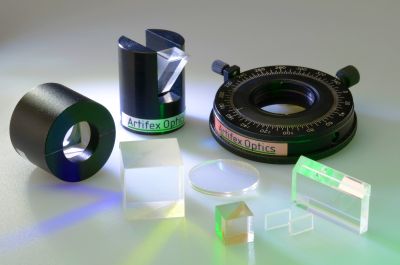refraction (original) (raw)
Definition: the change in the propagation direction when a wave comes from one medium into another one
- optical effects
- absorption
- birefringence
- diffraction
- dispersion
- dispersive waves
- evanescent waves
- Faraday effect
- focusing
- imaging
- interference
- optical aberrations
- optical phase shifts
- phase matching
- photodarkening
- polarization changes
- propagation losses
- reflection
- refraction
- scattering
- spatial walk-off
- superluminal transmission
- temporal walk-off
- thermal blooming
- thermal radiation
- total internal reflection
- wavefront distortions
- nonlinear optical effects
- electro-optic effect
- (more topics)
Related: refractive indextotal internal reflectionvelocity of lightFresnel equationsprismschromatic dispersion
Page views in 12 months: 1476
DOI: 10.61835/vke Cite the article: BibTex BibLaTex plain textHTML Link to this page! LinkedIn
Content quality and neutrality are maintained according to our editorial policy.
📦 For purchasing birefringent materials, use the RP Photonics Buyer's Guide — an expert-curated directory for finding all relevant suppliers, which also offers advanced purchasing assistance.
Contents
Typical Cases Involving Refraction
Negative Refraction and Superprism effects
Why does light change direction when entering a different medium?
What are some common applications of refraction?
What is total internal reflection?
Summary:
This article provides a comprehensive introduction to the phenomenon of refraction, which is the change in the propagation direction of light when it passes from one medium to another. It explains the physical origin of refraction and presents Snell's law, which mathematically describes the relationship between the angles of incidence and refraction and the refractive indices of the media.
The text also covers various important applications, such as in optical lenses and prisms, and related phenomena including total internal reflection, double refraction in birefringent materials, and more exotic effects like negative refraction in metamaterials.
(This summary was generated with AI based on the article content and has been reviewed by the article’s author.)
What is Refraction?
When light, e.g. a laser beam, propagates from one transparent homogeneous medium into another, its propagation direction will generally change (see Figure 1). This phenomenon is called refraction.
Refraction can be understood by considering the conditions which the incoming and the transmitted waves need to fulfill at the boundary between the two media. Essentially, the tangential components of the wave vectors need to be identical, as otherwise the phase difference between the waves at the boundary would be position-dependent, and the wavefronts could not be continuous. As the magnitude of the wave vector depends on the refractive index of the medium, the said condition can in general only be fulfilled with different propagation directions. An exception is of course the case of normal incidence, where the wave vectors have no component along the surface.

Figure 1: Refraction at an interface between two media.
From the above considerations, one can easily derive Snell's law (the law of Snellius) for the angles: {n_1}\sin {\theta _1} = {n_2}\sin {\theta _2}$$
where ($n_1$) and ($n_2$) are the refractive indices of the two media. It is apparent that the larger angle to the normal direction must occur in the medium with the smaller refractive index.
As the refractive index of typical optical materials is between 1.4 and 2, refraction often causes substantial changes in propagation angle, which can be significantly different for different materials.
Figure 2 is an animated illustration of refraction. One can see that the wavelength is smaller on the right side (as a result of the reduced velocity of light), where the refractive index is larger. Also, the wavefronts are not interrupted at the interface, but only changed in direction. This is possible only with a modified angle of propagation.

Figure 2: An animated illustration of refraction. The wavefronts are shown as gray lines. The change in direction results from the reduced velocity of light in the right medium.
The amplitude transmission and reflection coefficients of the boundary are described by the Fresnel equations.
Typical Cases Involving Refraction
The phenomenon of refraction is very often encountered in general optics and other fields of photonics:
- Refraction is used in most optical lenses.
- One may exploit wavelength-dependent refraction angles e.g. in prisms for separating different wavelength components.
- With birefringent optical materials, one may also obtain polarization-dependent angles. This is exploited, for example, in some types of polarizers.
- In some cases, light forces related to beam deflections by refraction are relevant.
Total Internal Reflection
If the incident beam comes from the medium with the higher refractive index, and its angle of incidence is large, it may not be possible to fulfill Snell's law with any output angle, since the sine of the output angle can be at most 1. In that case, transmission is not possible — total internal reflection occurs.
Lossy Materials
Snell's law holds for lossless materials, i.e., with negligible absorption. Alternative equations for lossy materials can be derived, but such analysis involves complicated considerations. For example, simply working with complex refractive indices leads to complex angles, which raises questions of how to interpret such angles. Also, situations with non-normal incidence of a plane wave lead to waves in absorbing media which are no longer plane waves, since there is a transverse variation of the modulus of the complex amplitude.
Note, however, that substantial deviations from Snell's law are to be expected only in cases where the imaginary part of the refractive index becomes substantial — which is not the case in many cases of practical interest.
Reflected Beam
For the reflected beam, the angle to the surface normal is always the same as that of the incident beam (($\theta_1$)): its direction is not affected by refraction.
Double Refraction
For non-isotropic media, the refractive index can depend on the polarization direction of the light. Therefore, the refraction angle can be polarization-dependent. One obtains double refraction: different output beams for s and p polarization.
Negative Refraction and Superprism effects
Unusual phenomena such as negative refraction [3, 4] can occur with photonic metamaterials with a negative refractive index, at certain photonic metasurfaces, or with certain photonic crystals. Here, the refracted beam can be on the same side of the surface normal as the incident beam.
Another curious refraction phenomenon is the superprism effect [1, 2], where the refraction angle exhibits an unusually strong dependence of the propagation direction at the output on details like the input direction and the optical wavelength.
Refraction of X-rays
For electromagnetic radiation at very high frequencies, such as X-rays, refraction effects are far weaker than for light, since the refractive index is then close to 1.
Frequently Asked Questions
This FAQ section was generated with AI based on the article content and has been reviewed by the article’s author (RP).
What is refraction?
Refraction is the change in propagation direction that light experiences when moving from one transparent medium to another. This phenomenon is described by Snell's law.
What is Snell's law?
Snell's law is a formula relating the angles of incidence ($\theta_1$) and refraction ($\theta_2$) to the refractive indices ($n_1$) and ($n_2$) of the two media: ($n_1 \sin \theta_1 = n_2 \sin \theta_2$).
Why does light change direction when entering a different medium?
The direction change is necessary to maintain the continuity of wavefronts at the boundary. As the velocity of light and wavelength change with the medium's refractive index, the propagation angle must adjust to keep the phase relationship constant along the interface.
What are some common applications of refraction?
Refraction is a fundamental principle used in many optical components, including lenses for focusing or imaging light, and prisms for separating different wavelength components.
What is total internal reflection?
Total internal reflection occurs when light travels from a medium with a higher refractive index to one with a lower index at a sufficiently large angle of incidence. Beyond a certain critical angle, the light cannot be transmitted and is completely reflected.
What is double refraction?
Double refraction occurs in non-isotropic (or birefringent) materials, where the refractive index depends on the polarization of light. As a result, an incident light beam can be split into two beams with different polarizations, which are refracted at different angles.
Suppliers
Sponsored content: The RP Photonics Buyer's Guide contains 26 suppliers for birefringent materials. Among them:
⚙ hardware
We offer a wide range of polarizers and polarization optics for many different uses. Choosing the right polarization optic for your application can be a bewildering task, as we offer a wide range for many different uses.
A brief tutorial is available on our website.
Feel free to contact us for assistance. Our experienced staff is only too pleased to help you with the decision process.
⚙ hardware🧩 accessories and parts🧴 consumables🔧 maintenance, repair📏 metrology, calibration, testing💡 consulting🧰 development
Shalom EO offers various birefringent materials, including: MgF2 crystals, LiNbO3 and alpha-BBO crystals, quartz crystals, calcite crystals, and YVO4 crystals. The crystals exhibit excellent properties when used to make waveplates, Glan and Thompson polarizers, and other optical components. Crystal ingots, blanks, and polished and coated optical elements made of birefringent crystals are offered according to your request.
Shalom EO also offers other optical crystal materials, including: nonlinear crystals, laser crystals, and electric-optical and acousto-optic crystals.
Bibliography
| [1] | H. Kosaka et al., “Superprism phenomena in photonic crystals”, Phys. Rev. B 58, R10096 (1998); doi:10.1103/PhysRevB.58.R10096 |
|---|---|
| [2] | H. Kosaka et al., “Superprism phenomena in photonic crystals: toward microscale lightwave circuits”, J. Lightwave Technol. 17 (11), 2032 (1999); doi:10.1109/50.802991 |
| [3] | S. Foteinopoulou, E. N. Economou and C. M. Soukoulis, “Refraction in media with a negative refractive index”, Phys. Rev. Lett. 90, 107402 (2003); doi:10.1103/PhysRevLett.90.107402 |
| [4] | E. Cubukcu et al., “Negative refraction by photonic crystals”, Nature 423, 604 (2003); doi:10.1038/423604b |
| [5] | N. Yu, “Light propagation with phase discontinuities: Generalized laws of reflection and refraction”, Science 334 (6054), 333 (2011); doi:10.1126/science.1210713 |
| [6] | F. Aieta et al., “Out-of-plane reflection and refraction of light by anisotropic optical antenna metasurfaces with phase discontinuities”, Nano Lett. 12, 1702 (2012); doi:10.1021/nl300204s |
| [7] | S. Larouche and D. R. Smith, “Reconciliation of generalized refraction with diffraction theory”, Opt. Lett. 37 (12), 2391 (2012); doi:10.1364/OL.37.002391 |
(Suggest additional literature!)
Questions and Comments from Users
Here you can submit questions and comments. As far as they get accepted by the author, they will appear above this paragraph together with the author’s answer. The author will decide on acceptance based on certain criteria. Essentially, the issue must be of sufficiently broad interest.
Please do not enter personal data here. (See also our privacy declaration.) If you wish to receive personal feedback or consultancy from the author, please contact him, e.g. via e-mail.
By submitting the information, you give your consent to the potential publication of your inputs on our website according to our rules. (If you later retract your consent, we will delete those inputs.) As your inputs are first reviewed by the author, they may be published with some delay.
 general optics
general optics


